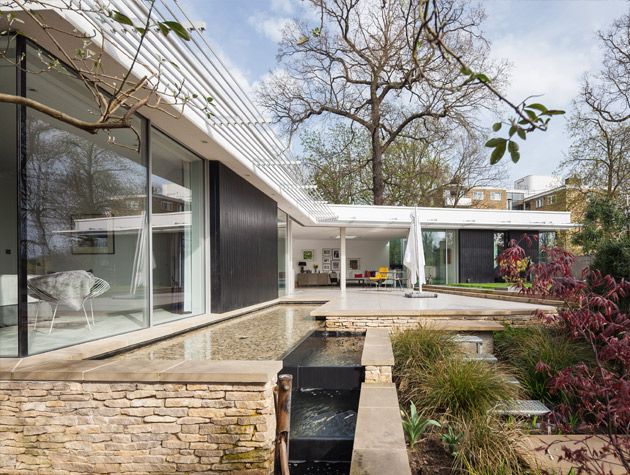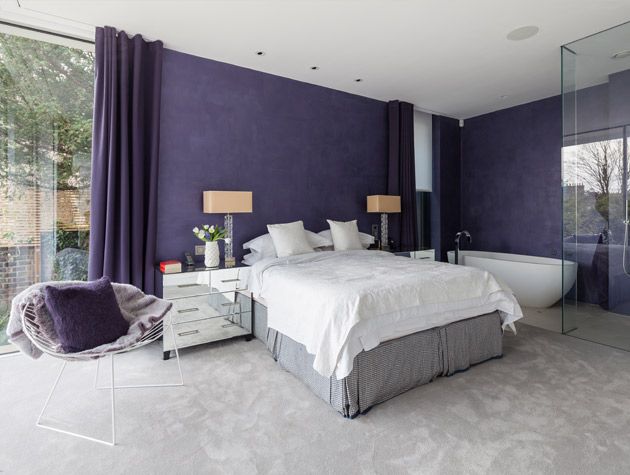Zero-carbon new-build in Blackheath, London
Caroline and Philip's dream of building a sustainable property became a reality
When Caroline and Philip Cooper’s children had flown the nest and they were left rattling around in a seven-bedroom period home, the couple decided it was time for a lifestyle change.
Not only did the practicalities of downsizing appeal to them, but they were also drawn to the ideal of living in a modern and more sustainable way.
‘Our old family home was an eighteenth-century property that had originally been built as a Chinese folly for the Duke of Buccleugh,’ Caroline explains. ‘It had been through several families until it was eventually bought by the council in the Seventies and turned into a children’s home. It then fell into disrepair and we bought it in the Nineties, spending a lot of time and money refurbishing the house over subsequent years.’

Photo: Matt Chisnall
With a large garden to maintain and rooms that were now surplus to requirements, the Coopers found that they were increasingly spending their time in the kitchen.
‘We seriously considered moving the kitchen into a huge drawing room that we rarely used, but it just seemed too dreadful a thing to do and would have ruined the original period interior,’ Caroline admits. ‘It became obvious that the house was no longer fit for our needs, and both Philip and I felt that we were ready for the challenge of a new-build project, combining my interior design skills and Philip’s building background.’
With a large garden to maintain and rooms that were now surplus to requirements, the Coopers found that they were increasingly spending their time in the kitchen.

Photo: Matt Chisnall
‘We seriously considered moving the kitchen into a huge drawing room that we rarely used, but it just seemed too dreadful a thing to do and would have ruined the original period interior,’ Caroline admits. ‘It became obvious that the house was no longer fit for our needs, and both Philip and I felt that we were ready for the challenge of a new-build project, combining my interior design skills and Philip’s building background.’
The couple began looking for a plot in their local area of Blackheath, south-east London, but finding something suitable proved problematic.
After several attempts at making offers for building sites and having them fall through, a chance comment from a friend made the Coopers realise that the answer was staring them in the face.

Photo: Matt Chisnall
‘Our friend suggested that we had a viable plot at the bottom of our garden, but we’d never considered it as there was a large tree there and we didn’t think we’d get permission to build,’ Caroline recalls. ‘We consulted with an arboriculturist, who concerned that the tree was diseased and could be taken down, which would then give us room to construct a new dwelling.’
Excited by the prospect of a project that was just metres from their back door, the couple asked their son, architect Sam Cooper, to produce a design package that could be presented to the council for planning consideration.
‘Sam is into eco design and, as this had been his family home, he knew the house intimately and was attuned to the site,’ Philip adds. ‘I made up a feasibility sketch and set out a design brief to show what we wanted in terms of accommodation, but the final design was very much Sam’s.’

Photo: Matt Chisnall
With the constraints of a garden plot, the need to keep the building low so as not to obscure the Coopers’ listed former home, and to orientate the new-build to the south-west to maximise the use of natural daylight, Sam designed an open, L-shaped form.
This ensured there would be no one vantage point on the ground where you could see the whole composition. The house was also to have very high thermal efficiency and plenty of eco features, with an expectation that it would satisfy Level 5 of the Code for Sustainable Homes.
Unfortunately, even the best laid plans can fall foul of the planning application process, and the Coopers became increasingly frustrated as the months went by.
‘Sam had put together a beautiful package of information, backed up by a consultant planner, historian and sustainability engineers,’ Philip says. ‘We found out that residents surrounding us had objected strongly, voicing concerns about parking and the fact it was a contemporary structure. Our application was turned down without the council even looking at our plans and detailed information within the package. They didn’t even realise that it was an eco build, or that residents in a nearby estate would actually benefit from an additional parking space within the proposals.’

Photo: Matt Chisnall
Feeling that they hadn’t been given a fair hearing, the Coopers pressed on for a public enquiry, involving English Heritage and The Georgian Group.
‘It was a nail-biting time, but after 10 months of arguing with the planners, their objections were quickly resolved and permission was, at long last, granted,’ Caroline says. ‘We finally put the building work out to tender in April 2011 and broke ground in September.’
As any self-builder will confirm, the coming months included high and low points. ‘At no time did we ever fall out with Sam; in fact it made us all a lot closer,’ Caroline says. ‘The structure came together and all the eco technology was fitted. We dug bore holes to locate the ground source heat pump, which provides hot water and underfloor heating, along with photovoltaic panels fixed on the roof to produce electricity.’

Photo: Matt Chisnall
Achieving the exacting Code 5 eco status meant including rainwater harvesting into a tank via the roof and through gaps between the patio tiles, normally reserved for grouting.
‘To be Code 5 we’re allowed to use only eighty litres of water a day, so all our kitchen appliances are triple A-rated and our taps have restricted flow,’ Caroline adds. ‘An integrated computer system monitors everything and it’s so amazing. If we forget to shut one of the roof lights and it starts to rain, the system will automatically close it. We also employ a specialist who can service the house remotely and we’ve learned to manage the house ourselves via our iPhones or iPad.’
The building is located in the middle of the site so that the garden surrounds and covers it; it’s only as you move through and around the property that the different aspects and spaces are visually connected.
Each room relates to a different part of the garden and every window frames a view out into the landscaping. The glazed wall of the open-plan living area opens from the corner, so that the upper terrace becomes part of one large space over the roof of the lower-ground floor.

Photo: Matt Chisnall
With the build completed in September 2014, the Coopers moved in and quickly embraced their new, technologically advanced home.
‘Our house is constantly monitored to see how it’s performing, which is fascinating,’ Caroline says. ‘If we have built a ground breaking design that could be used as an example for the benefit of other self-builders, that would be an amazing achievement. As for us, we’re still getting used to all the gadgets, but the whole experience of living in such a unique building is truly invigorating, and heralds an exciting new phase in our lives.’









